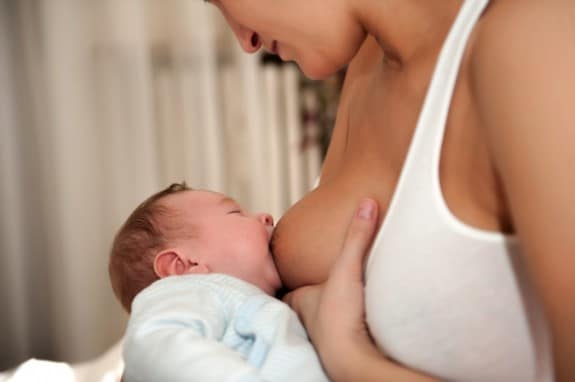In a “baby-friendly” hospital, naked newborns are placed on their mother’s bare chest within just one hour of birth. Mothers are encouraged to nurse “on demand” rather than on a schedule. Pacifiers don’t exist, and the formula is only available upon request. Mothers may also be asked to sign a waiver in which they are asked to acknowledge that bottle use could negatively impact breastfeeding. Healthy babies rarely go to the nursery, and if a mother wants to send her infant to the nursery, she may have to provide the reason and fill out paperwork. Lactation consultants roam the halls, awaiting the questions that new mothers are likely to have.
Is this a solution to rising health issues in the United States? Or is it unwanted and unnecessary pressure on new mothers?
Although the initiatives are designed to hopefully encourage breastfeeding and provide lactation support to new moms, some mothers feel that the new push – first initiated by the U.S. Department of Health and Human Services back in 2010 – feel too much like the old decades where “lactivists” were accused of trying to guilt women into breastfeeding rather than bottle feeding.
Lisa Stone, who delivered her daughter in December at Inova Alexandria Hospital said that, because she travels frequently for her position at a non-profit group, she’d already decided not to breastfeed.
“Yet, right after my daughter was born, they were ripping open my gown and trying to set the baby up to breastfeed. It was really uncomfortable.” the 30-year-old mother told Washington Post. “I certainly think if you want to have your baby next to you all night, and that makes you feel better, you should have that choice. My problem was feeling like I was forced into that position.”
Lisa isn’t the only mother that’s been unhappy over the new policies, which have been adopted by more than 3,000 hospitals, nationwide. But there seems to be one rather common thread with most of these mothers: many of them felt blindsided by the new policies.
With mothers that had given birth within the last few years, the concern seemed to rest with the lack of knowledge when it came to how or why the hospitals had changed their policies. In other cases, it seemed to simply be an issue of the hospital making some missteps while undergoing the transition to “baby friendly.”
According to Carol Chornock, the lactation consultant and coordinator at Shady Grove hospital in Maryland, both issues are easily avoided through intensive education and outreach with the community as well as the hospital staff itself. That way, everyone knows what to expect.
At Shady Grove, where a great deal is placed on education, the new breastfeeding initiatives have boosted breastfeeding rates when mothers leave the hospital from just 30 percent back in 2010 to 90 percent today. This is the highest percentage in the state of Maryland, Chornock said.
Beth Groves, interim clinical nurse manager of the Mother Baby Unit at Shady Groves, said that, despite the breastfeeding-friendly environment, where babies are tested, weighed, measured and bathed in the mother’s suite instead of the nursery whenever possible, the staff is taught to place focus on the respecting a mother’s choices rather than the goal of breastfeeding.
“Our aim is not to make anyone feel guilty,” Groves said. “There is no right or wrong in motherhood.”
But what about the other hospitals that have adopted the practices? Are many of them creating experiences like Lisa’s? Probably.
“The staff and physicians here have taken great pride at being advocates for mothers who want to breastfeed,” Patricia Schmehl, vice president and administrator of Inova’s Women’s Hospital. “People are very passionate about this. Does it move from passionate to overzealous? It may have.”
But there are also a lot of positive experiences – experiences like those of Mandeep K. Virk-Baker, a 33-year-old mother who gave birth to a baby girl back in September. She says she believes that, without the baby-friendly procedures at Shady Grove, she never would have been able to breastfeed.
“I had all the book knowledge in the world, but no practical knowledge, and it first, it was really frustrating,” Mandeep told The Washington Post. “We had to learn it together.”
For her, having the baby in the room was a big help, but probably the most important things to her were the hours of education she received at the hospital before birth and the hours that nurses spent with her, one-on-one, encouraging and helping her with breastfeeding.
“I just can’t see any other type of hospital where we would have this beautiful an experience,” Sam Virk-Baker, the father told The Washington Post. Because of his wife’s difficult 140 hour labor, he was the one permitted to hold their daughter, skin to skin, immediately after birth.
So the program truly does have the potential to change the lives of parents and their infants for the better . . . but, like most things, change in hospital procedures takes time to perfect.
“We’re trying to change a hospital culture that has been in place for many, many decades,” Trish Macenroe, executive director of Baby-Friendly USA, told The Washington Post.
A culture in which free formula at hospitals has become a norm, and many mothers are still sent home with formula and bottles for their healthy babies. Even healthy, breastfeeding babies are carted off to nurseries at regular intervals for testing, bathing, and in some cases, for no real apparent reason. So, truth be told, 3,000 hospitals is just a drop in the bucket. In fact, as of 2011, 78 percent of hospitals still promoted non baby-friendly policies.
But the HHS has lofty goals – goals of having at least 8.1 percent of all hospitals certified as “baby friendly” by 2020. And, whether breastfeeding or bottle feeding, most moms are likely to reap those benefits once things start to really come together inside of hospitals that are promoting the practice.
“It’s a myth that moms sleep better when the baby’s in the nursery,” Macenroe, whose organization has been designated by the World Health Organization to certify hospitals across the country. “Research shows that moms sleep better when babies are closer to them.”
We can only hope that, as time goes on, every mother begins to feel more comfortable with the new policies and how they are implemented – as well as the real reason behind them – happier, healthier moms and babies.
Related Articles:
- Study: Autism Intervention at Six Months of Age May Eliminate Symptoms & Developmental Delays
- Breastfeeding may Help Reduce Long-Term Weight Retention for Mothers Suffering from Obesity
- Exposure to Certain Phenols While In Utero May Disrupt Growth during First Year of Life for Boys







